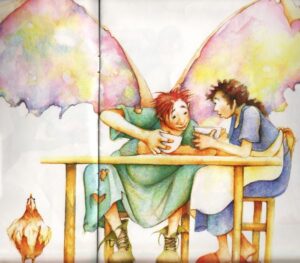
Feast of the Annunciation and the YES that changed the world


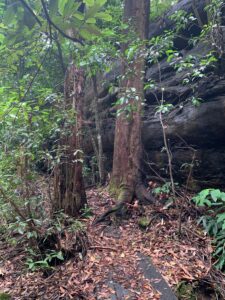
Portal
a narrow passage
between two ironbarks
into an earthy world
of closed off skies
mossy sandstone caverns
moist soft tracks
each step cushioned
by sweet smelling
leaf mulch so absorbing
i feel I’m hardly here
this subtle cut
into another reality
like crossing over
to a liminal world
with life’s great tumult
falling away
as bark falls from trees
seduces slowly
my restlessness
disesolving
Colleen Keating
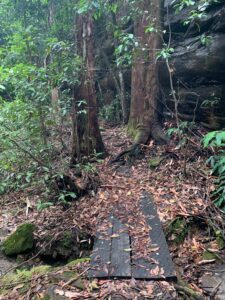


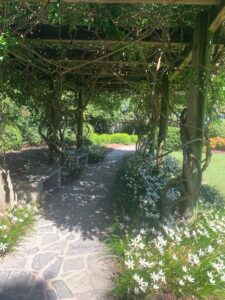
As soon as we met up for this meeting we knew it was going to be a very special one indeed. The sun was gently shining and all the diverse shades of green in the garden were sparkling. Soon we were off for our ginko and silent jotting. Smiles across the ponds and along the pathways.
At 11 o’clock we gathered at the round table in the downstairs room we hire, which has glass doors that overview a quiet end of the garden. We were very sorry that two of our regular members, Samantha Hyde and Maire Glacken, were unable to attend this time, but were pleased to greet two visitors, Meredith Ferris and Frances Carleton, and our guest presenter, Carole Harrison, each of whom joined in congenially with our group and enhanced the day. Carole was one of the organisers and presenters of ‘Haiku Down Under’ on-line conference October 7-9 2022 and editor and cover-illustrator of ‘Poetry From The Edge’ the conference anthology. Members present at our meeting were Marilyn Humbert, Kent Robinson, Gwen Bitti, Colleen Keating, Verna Rieschild, Michael Thorley and Beverley George.
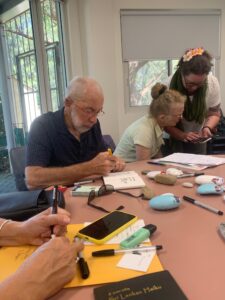
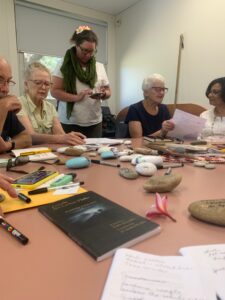
We shared a haiku we had each brought with us and one we had jotted on our ginko. Then it was time for our main session led by Carole Harrison, who had kindly journeyed up from Jamberoo, as she did for a Bowerbird tanka group meeting in the Pearl Beach Arboretum last year. Her presentation was to show us how we might write haiku on stones, some of which were partly painted, others left plain. To this end Carole brought with her the stones we would use and Kent brought some dark river stones he had gathered for the purpose. Carole also brought the writing implements we needed and we wrote on two stones each – a lovely way in which to further share and enjoy haiku. It was relevant to add a simple drawing such as a leaf or feather to some of the haiku.
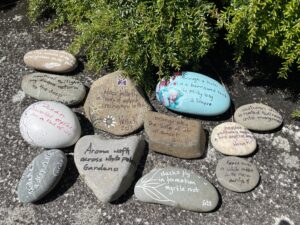
Kent Robinson had prepared and distributed an article about writing rengay and spoke briefly about this interesting genre. His thoughts were helpful and appreciated.
At 12:30 our meeting ended and it was up to each person whether to share lunch, journey home or enjoy the Art Gallery, or another garden stroll. This is an aspect of our meeting location that works well for everyone, especially those who have travelled long distances to be there.

I am looking forward already to our winter meeting in June.
Beverley George
Convenor
White Pebbles Haiku Group



waiting out a storm
when wild weather is forecast 
we set out to escape
plan things to wile away the time
rather than waiting for it to hit
when clouds blow in dark and threatening
we pack a picnic
seek out nature
and find consolations
in the shadow of
doctors reports tests
verdicts more tests and treatments
nature is the antidote
the sun on our back
the wind in our hair
the balmy smells of the outdoors 
we find the secret to living.
Colleen Keating






Ku-Ring-Gai Wildflower Garden for a walk in nature and picnic. It was a hot , balmy day and although we walked a lot in shade the eucalypt aroma was wonderful.
The heady, healing eucalypt aroma as we walked made us feel very positive.
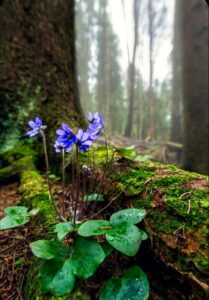
O fleeting soul, be strong.
Clothe yourself in the armour of light.
You are surrounded
With the embrace of Divine mysteries.
It is affirming when I hear Hildegard of Bingen, a Poetic Journey, my book published a few years back has an effect on the reader. Because my story is read mostly in USA with book groups and retreats, I love hearing of experience from a distance but when it is from home and from a friend that it has been inspiring for her through grief and lost and deep sadness into new creative musical writing, I feel very affirmed and give thanks to Hildegrad who is with us today in 2023 to lead us in this broken world.
Thank you professor Anne Boyd. I feel very honoured to be included in your creation and so happy you are being praised as one of the top women composers at this time. And congratulations being on the new CD of music Women of Note Vol 5. published this month March 2023 for International Womens’ Day
Short Programme Note
Into the Living Light
For me, composing is deep listening, seeking a presence beyond the Self, an activity akin to prayer. Grieving the recent loss of two family members, one of whom was my older sister Helen, who died on Christmas Day, I discovered the loss of a sibling leaves a strangely hollow place in one’s sense of being. My very special friend David Iverach was similarly affected with passing of his elder brother Don a few days later.
O fleeting soul, be strong.
Clothe yourself in the armour of light.
You are surrounded
With the embrace of Divine mysteries.
The image of Light so important to Hildegard’s sense of the Divine presence, reaches across many spiritual beliefs. I sometimes think of Australia as the land of living light.My sister, to whom the vibrant colours of Nature were soul food,believed her onward journey to be ‘to a place beyond the stars’; Don had no doubt that his resting place would by with his wife in the loving arms of Jesus. Light is central to and connects both their personal beliefs. This music, resting upon inspiration from Hildegard, reaching across the centuries, is a kind of prayer to accompany them both into eternity.
Vale Helen and Don, both so loved by your families and friends in this life, may you now rest in peace.
Anne E. Boyd
Sydney
20.02.23

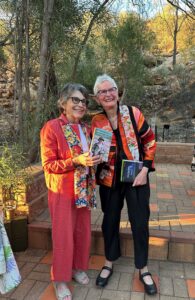
The sumptuous combination of flute, viola and harp unites three soloists as they deliver a thoughtfully curated program. The newly established Australian Debussy Trio has crafted an illuminating blend of tranquil dreams, pastoral scenes and deep, introspective music for this unique instrumental combination. Imbued with flickers of light, Debussy’s second sonata is told in a fragrant language of ambiguity and fleeting suggestion. In a masterful display of timbral manipulation, Japanese composer Tōru Takemitsu pays homage to Debussy with his own trio “And then I knew ’twas Wind” – a musical depiction of the human subconscious played out across interconnected musical episodes. Amongst the intriguing lineup of works, the programme features two Australian works, by Ross Edwards and Anne Boyd, written especially for the trio. This thoughtful programme will engross audiences from start to finish.
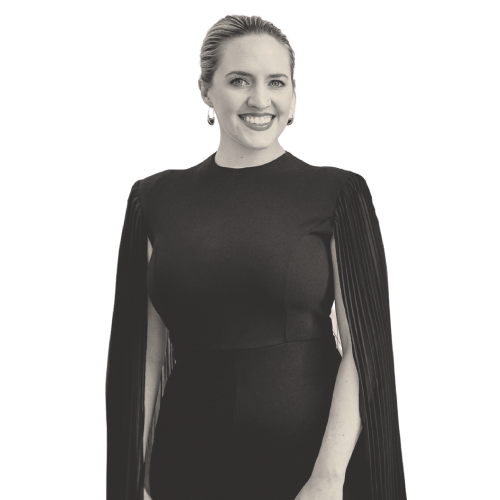
See profile
American-born, Australian-based Emily Granger effortlessly straddles the worlds of classical, popular, and art music – including glittering appearances with Yo-Yo Ma, Sarah Blasko, and Renée Fleming. Emily’s considerable talent finds her equally at home in intimate chamber recitals and thrilling performances of daring new works. Emily has performed recitals from Carnegie Hall to the Kennedy Center and has appeared with the Chicago, Sydney, and Tasmanian Symphony Orchestras. Her debut solo album, In Transit (AVIE Records), was Featured Album on ABC Classic and praised by BBC Music Magazine as “beautiful” and Limelight Magazine as “an impressive debut”.
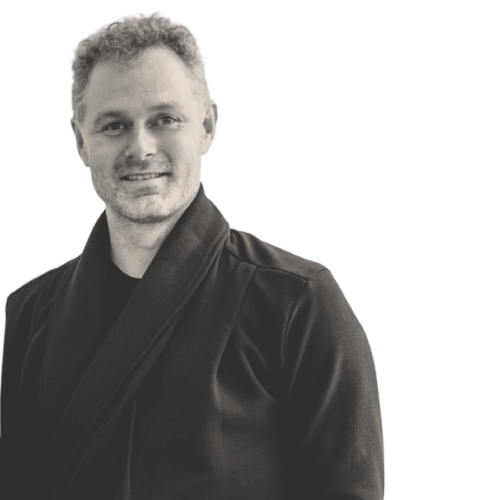
See profile
Violist James Wannan is a founder of the Australia Piano Quartet (APQ), Co-Artistic Director of the Ensemble in Residence at the University of Technology Sydney, a member of Southern Cross Soloists and an Artistic Associate of Sydney Chamber Opera. He teaches chamber music and viola at the Sydney Conservatorium’s Rising Star program and has been a guest teacher at the Australian National Academy of Music. He explores his passion for music from ancient to contemporary on a number of instruments. James enjoys exploring the possibilities of other instruments including violin, oud and viola d’amore. He has commissioned many new works, including a concerto by Jack Symonds that was premiered at the Bendigo Festival of Experimental Music.
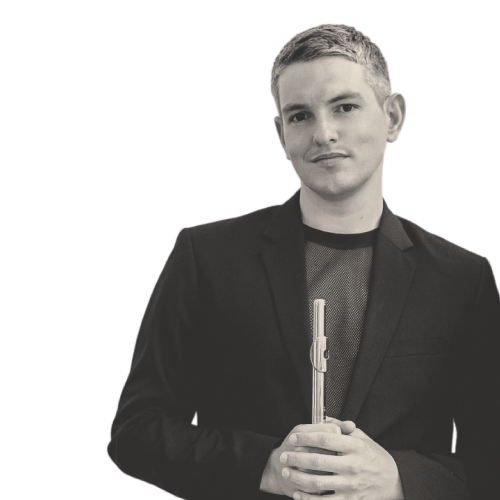
See profile
Flutist Jonathan Henderson trained with Europe’s leading flute professors and has carved out a multifaceted performance career spanning from Australia to the Nordic countries. Jonathan was appointed Principal Flute of the Estonian National Opera Orchestra at age twenty-four, whilst still a student at the Hochschule für Musik Freiburg. He has performed with the Australian Chamber Orchestra, Queensland Symphony Orchestra, Helsinki Philharmonic Orchestra, Nordic Symphony Orchestra and MDR Leipzig Radio Symphony Orchestra under the direction of conductors such as Sir Mark Elder, Neeme Järvi, Paavo Järvi, Richard Tognetti, Klaus Mäkelä and Leif Segerstam.